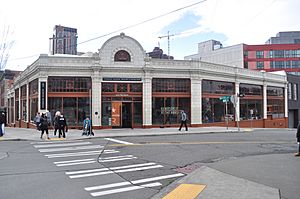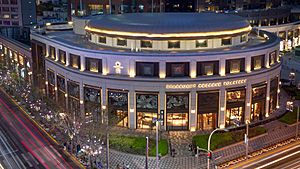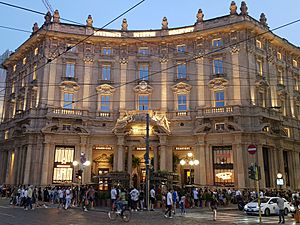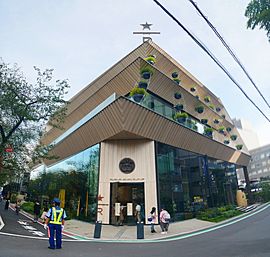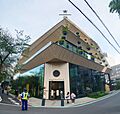Starbucks Reserve facts for kids
| Industry | Coffee |
|---|---|
| Founded | 2010 |
| Parent | Starbucks |
Starbucks Reserve is a special part of the international coffee company Starbucks. It focuses on offering rare and high-quality coffees. This program includes large coffee roasting places called roasteries. There are currently 8 of these amazing places around the world.
The program also has 43 special coffee bars. These bars serve Starbucks Reserve products. These are coffees that Starbucks considers its most unique and best quality. They are often single-origin coffees, meaning they come from one specific place. The main Starbucks office in Seattle also has a Reserve Store. It is a marketplace and bar that sells these special Reserve products. You can also find some Starbucks Reserve coffee in about 1,500 regular Starbucks stores.
Contents
How Starbucks Reserve Started
Starbucks began this program because it wanted to offer very special coffee. They wanted to compete with other companies that sold high-quality coffee. Some of these companies included Stumptown Coffee Roasters and Blue Bottle Coffee.
The Starbucks Reserve program started in 2010. At first, they sold small amounts of special arabica coffees online. They also sold them in a few of their regular stores. Later, Starbucks opened its first Reserve location. It was a three-story store in Latin America. This store only sold coffee from Colombia. The very first Starbucks Reserve roastery opened in Seattle in December 2014.
Types of Starbucks Reserve Locations
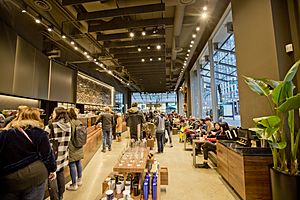
Starbucks Reserve has three main types of places you can visit. These are the "Starbucks Reserve Roastery", the "Reserve Bar", and the "Reserve Store". Each offers a different experience.
Starbucks Reserve Roasteries
Roasteries are very large places, often tens of thousands of square feet. People often describe them as a "theme park" for coffee lovers. They have coffee bars where you can try different coffees. There are also cocktail bars and areas where you can watch coffee being roasted and brewed. You can buy food there, and see local artwork. These big places also roast, package, and send coffee to other stores in their area.
Starbucks has roasteries in several major cities. These include Seattle, Washington (opened 2014), Shanghai (2017), Milan (2018), New York City (2018), Tokyo (2019), and Chicago, Illinois (2019). Starbucks plans to open 20 to 30 roasteries around the world.
Reserve Bars
Reserve Bars are regular Starbucks stores that also sell some Starbucks Reserve products. These products are sent from a regional roastery. There are 43 Reserve Bar locations. They all have the usual Starbucks menu. They also have a special coffee bar. This bar gives you a similar experience to the coffee bars found in the larger roasteries.
Reserve Store
There is only one Reserve Store right now. It is in Seattle, on the first floor of the main Starbucks office. This store has a cocktail bar and a marketplace. It sells coffee drinks similar to those found in Reserve bars and roasteries.
Amazing Roasteries Around the World
Seattle Roastery
The first Starbucks Reserve roastery opened in December 2014. It is in the Capitol Hill area of Seattle. This roastery is about 15,000 square feet. It is said to have cost around $20 million to build. The roastery has a cool "split-flap display". This is like the old-fashioned boards you used to see at train stations. It shows which coffees are being roasted. This special board was made by a company called Solari di Udine.
Shanghai Roastery
The roastery in Shanghai, China, is very popular. It is located in a big shopping area called HKRI Taikoo Hui. It opened in December 2017. It was the largest Starbucks location in the world for a while. The Shanghai roastery is 30,000 square feet and has two floors. It is often very crowded, with lines of people waiting to get in.
This roastery has a roasting area and three coffee bars. It also has a Teavana tea bar. A cool feature is an augmented reality experience. You can use the Alibaba Taobao app to learn about coffees and the roasting process. The store also has a marketplace and a wine and beer tasting area. You can buy bags of beans and try different coffees. A huge, two-story bronze cask is in the middle of the store. It is decorated with 1,000 hand-engraved Chinese symbols. These symbols tell stories about the company and coffee. The cask weighs 40 tons and holds roasted beans. These beans are sent through pipes around the building to be used. One of the coffee bars is 88 feet long, making it the longest Starbucks coffee bar ever. Like Seattle, it has an old-style split-flap display. This board shows which coffee varieties are being roasted. Many of the beans come from China's Yunnan province. The roastery also has a Princi location, which sells pizzas and focaccia bread. There is a coffee library with books about coffee history and art. The Teavana bar is popular because tea is very important in China. It offers many different teas and tea drinks.
Milan Roastery
The roastery in Milan, Italy, is in a beautiful old building. This building, called Palazzo Broggi, used to be the city's stock exchange and main post office. It is in Piazza Cordusio, a central city plaza. The roastery opened on September 7, 2018. It was the very first Starbucks to open in Italy. It is also the only roastery in Europe. At 25,000 square feet, it is the largest Starbucks in Europe. Milan was chosen because Howard Schultz, the former Starbucks CEO, visited the city in 1983. His visit inspired him to add espresso drinks to Starbucks and create the coffee shop chain.
The inside of the Milan roastery was designed to fit its Italian location. Most Starbucks stores use warm materials like wood. But for Milan, they used Calacatta marble counters. Marble is common in fancy Italian coffee shops. These counters even have a heating system to keep them warm.
The Milan location has a main bar with seven different coffees. There is also a self-service bean bar and a bakery with a wood-fired oven. A Princi area serves food. There is a shop and an "Arriviamo" cocktail bar. This bar serves coffee-based cocktails and Italian drinks like the Aperol Spritz. The main bar has a unique "affogato" station. Affogato is ice cream with an espresso shot poured over it. The ice cream is made fresh with liquid nitrogen! The coffee roasted here is used in Starbucks stores across Europe, the Middle East, and Africa.
New York City Roastery
The New York City roastery is in the Chelsea neighborhood of Manhattan. It is on the first floor of a building at 61 Ninth Avenue. This location is 23,000 square feet. It has a coffee roastery, two coffee bars, a cocktail bar, a bakery, and even a terrarium. The bakery, run by Princi, sells baked goods, pizzas, salads, and breads. The cocktail bar, called "Arriviamo Bar", serves drinks made with coffee and tea. The ceiling inside looks like the outside of the building. The terrarium looks like Hacienda Alsacia, a coffee farm in Costa Rica. This is the only coffee farm owned by Starbucks.
Tokyo Roastery
The Tokyo roastery opened in Tokyo's Nakameguro area on February 28, 2019. It is about 32,000 square feet. It was designed by Kengo Kuma and built using Japanese cedar. This is the only Reserve Roastery that was built specifically for Starbucks. The other roasteries use existing buildings. The inside has four floors, each with Japanese cultural designs. The first floor has the main coffee bar. The second floor has a Teavana tea bar with 18 different teas. The third-floor cocktail bar, "Arriviamo Bar", has coffee and tea cocktails. It also serves Japanese versions of classic cocktails and non-alcoholic drinks. The fourth floor has the "Amu Inspiration Lounge". This is an event space that will be a training spot for coffee experts.
A huge 56-foot-tall copper cask is central to the space. It is made of 121 copper plates, hammered by hand in a Japanese style. This cask holds roasted coffee beans. It lets them settle before they are brewed or packaged. Around the cask, 2,100 copper cherry blossoms hang from the ceiling. This is a tribute to the nearby Meguro River, which is famous for its cherry trees. Copper pipes extend from the cask. They carry coffee beans to different parts of the store. The facility has two roasters. They can roast up to 4,000 pounds of coffee every day. This coffee is used in the roastery and sent to stores across Japan.
Chicago Roastery
The Chicago roastery opened on November 15, 2019. It is the largest Starbucks location in the world. The building is at 646 North Michigan Avenue, on the "Magnificent Mile". It has five stories and is 35,000 square feet. It used to be a flagship store for Crate & Barrel. The roastery has a coffee bar, a cocktail bar, and an Italian-style sandwich shop. Starbucks worked with the original architects of the building to remodel the space.
Inside, there are eight 56-foot-tall copper tubes. These tubes move coffee beans from one floor to another. Each floor has a different theme and special treats. The first floor is where customers can get coffee and snacks to go. They can also buy souvenirs. The second floor has a Princi location. It sells pastries, croissants, cannoli, and cheesecakes. You can also find pastas and pizzas on this floor. The third floor has barrels filled with cold brew coffee from Guatemala and other rare coffees. The roastery's cocktail bar is on the fourth floor. It serves both classic and new drinks. The fifth floor is a roof terrace, but it is only open during warmer weather.
Images for kids


